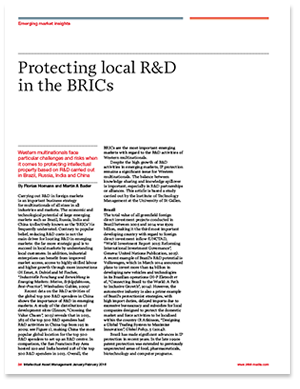Western multinationals face particular challenges and risks when it comes to protecting intellectual property based on R&D carried out in Brazil, Russia, India and China
Carrying out R&D in foreign markets is an important business strategy
for multinationals of all sizes in all industries and markets. The economic and technological potential of large emerging markets such as Brazil, Russia, India and China (collectively known as the ‘BRICs’) is frequently underrated. Contrary to popular belief, reducing R&D costs is not the
main driver for locating R&D in emerging markets: the far more strategic goal is to succeed in local markets by understanding local customers. In addition, industrial enterprises can benefit from improved market access, access to highly skilled labour and higher growth through more innovations (H Ernst, A Dubiel and M Fischer, “Industrielle Forschung und Entwicklung in Emerging Markets: Motive, Erfolgsfaktoren, Best-Practice”, Wiesbaden: Gabler, 2009)
Recent data on the R&D activities of the global top 500 R&D spenders in China shows the importance of R&D in emerging markets. A study of the distribution of development sites (Zinnov, “Crossing the Value Chasm”, 2013) reveals that in 2013, 385 of the top 500 R&D spenders had
R&D activities in China (up from 195 in 2009; see Figure 1), making China the most popular global location for the top 500 R&D spenders to set up an R&D centre. In comparison, the San Francisco Bay Area hosted 220 and India hosted 228 of the top 500 R&D spenders in 2013. Overall, the
BRICs are the most important emerging markets with regard to the R&D activities of Western multinationals.
Despite the high growth of R&D activities in emerging markets, IP protection remains a significant issue for Western multinationals. The balance between knowledge sharing and knowledge spillover is important, especially in R&D partnerships or alliances. This article is based a study carried out by the Institute of Technology Management at the University of St Gallen.






